 Case Report
Case Report
Fractured Tooth Reattachment of Vital and Non Vital Tooth: A Case Series
Dr. Nigel Antonio De Menezes1, Dr. Pranjal Bhosale2, Dr. Hemalatha Hiremath3*, Dr. Madhu Pujar4 and Dr. Aishwarya Sinha5
1Post graduate student, Department of Conservative Dentistry And Endodontics, Maratha Mandal’s Nathajirao G. Halgekar Institute of Dental Sciences And Research Centre, Belagavi, Karnataka
2Post graduate student, Department of Conservative Dentistry And Endodontics, Maratha Mandal’s Nathajirao G. Halgekar Institute of Dental Sciences And Research Centre, Belagavi, Karnataka
3Professor, Department of Conservative Dentistry And Endodontics, Maratha Mandal’s Nathajirao G. Halgekar Institute of Dental Sciences And Research Centre, Belagavi, Karnataka
4Professor and Head, Department of Conservative Dentistry And Endodontics, Maratha Mandal’s Nathajirao G. Halgekar Institute of Dental Sciences And Research Centre, Belagavi, Karnataka
5Post graduate student, Department of Conservative Dentistry And Endodontics, Maratha Mandal’s Nathajirao G. Halgekar Institute of Dental Sciences And Research Centre, Belagavi, Karnataka
Dr. Hemlatha Hiremath, Professor, Department of Conservative Dentistry And Endodontics, Maratha Mandal’s Nathajirao G. Halgekar Institute of Dental Sciences And Research Centre, Belagavi, Karnataka, India.
Received Date: May 19, 2023; Published Date: June 16, 2023
Abstract
Fracture of coronal structure following dental trauma is one of the most common traumatic injuries of dental tissue. Among various treatment options available, fragment reattachment is one of the conservative and cost effective approaches to preserve the function as well as aesthetics of the patient. This paper, reports the management of two such cases using Biodentine to maintain vitality of tooth followed by fragment reattachment using fiber post as well as fragment reattachment of non-vital tooth has been described.
Introduction
The most frequent after effect of dental traumas, which predominately affects the anterior permanent teeth, is a crown fracture. The majority of tooth injuries involve dentin and enamel destruction rather than pulp exposure. The reports suggest that 70% of such injuries involve the maxillary central incisors followed by maxillary lateral incisors and mandibular incisors. The age of the dental patient, the degree of the fracture (severity and location of the invasion of the biologic width), the presence or absence of endodontic involvement, the presence or absence of the tooth fragment and its state of use, the occlusion and aesthetics, time constraints, and patient expectations all play a role in determining the appropriate course of treatment [1].
Treatment options include ceramic restorations (complete crowns, laminate veneers, or ceramic fragments), composite resin restoration, and fragment reattachment [2]. The ideal course of action for treatment is fragment reattachment when the tooth fragment is present and in good functioning condition. It is proposed as a simple and conservative option, it restores the morphological, functional, and esthetic aspects of the dentition, while maintaining the shape, contour, texture, color, and alignment of the natural teeth. Fragment reattachment can be considered a fast and lowcost treatment solution [1]. The rate of wear is the same as that for the natural tooth while composite resin will be worn away more quickly than enamel by the opposing dentition. The use of natural tooth substance clearly eliminates the problems of differential wear of restorative material, unmatched shades and difficulty of contour and texture reproduction associated with other techniques. As the reattachment procedure does not preclude any future treatment, whenever an intact fragment is available, reattachment of fractured fragment should be considered as a viable first treatment option.
This technique was first published in 1964, by Chosak and Eidelman. Since then, different preparation techniques with advances in aesthetic dentistry have been proposed [3]. The following case series describes the management of crown-root fracture of anterior teeth treated in a conservative manner, in which the dental fragment was used as the main restorative material.
Case Reports
Case 1
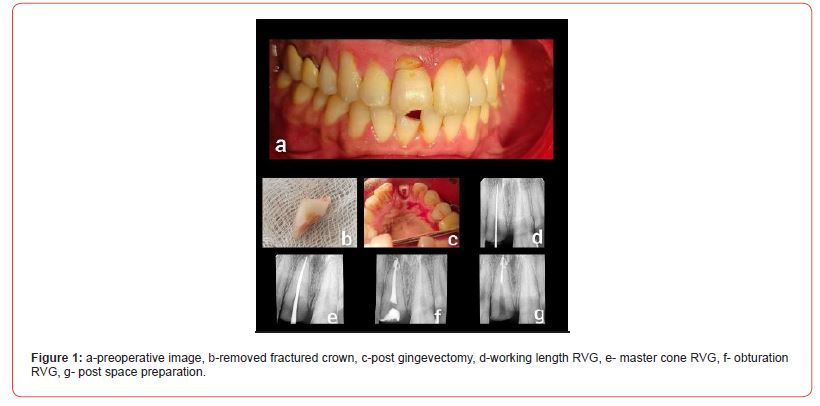
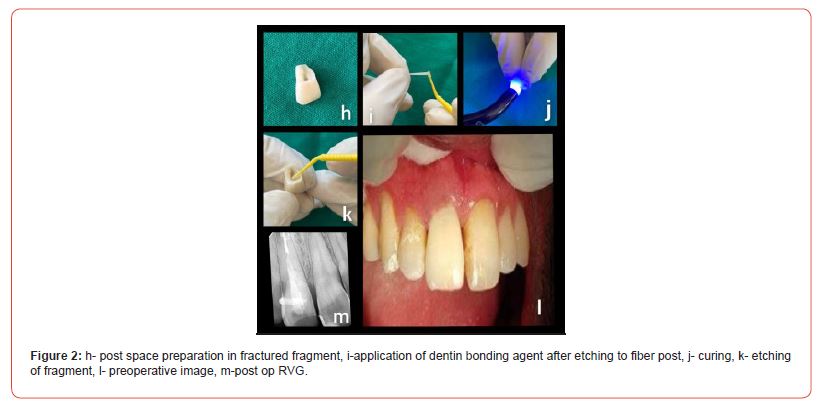
A 36 year old male reported to department of conservative dentistry and endodontics with history of road traffic accident. On clinical examination fracture line involving pulp with fractured fragment in line was seen. The treatment plan was root canal treatment followed by reattachment of fractured fragment. During its removal the tooth was retained by palatal gingival tissue. The removed tooth fragment was stored in normal saline following its removal for a period of 24 hours. Following gingevectomy, root canal treatment was initiated with access opening, determination of working length and biomechanical preparation followed by obturation. Although the application of rubber dam for the purpose of isolation provides an environment conducive to quality adhesive dentistry, but in this case, it was not to be used because the base of the fracture line was subgingival and the application of rubber dam clamp would have lead to excessive uncontrolled bleeding from the soft tissues, hence other means of isolation, such as cotton rolls, 2 × 2 gauze and high vacuum suction was used. After a period of 24 hours, post space was created. The attachment of the fragment to the remaining tooth structure was done using fibre post wherein post space was prepared 5mm short of apex for reinforcement as well as in the fragment to ensure stabilization. After which, the fragment was reattached using dual cure resin cement. (Figures 1, 2)
Case report2
A 21 year old male patient presented to the department of conservative dentistry and endodontics with coronal fracture of lateral incisor following trauma 8 days before. The patient also presented the fragment of the detached tooth that had broken due to trauma. Clinical examination revealed Ellis class III fracture in 22 with fracture line running horizontally mesio-distally on labial and palatal aspect (Figure 3b). Radiographic examination showed no periapical radiolucency and did not show any other fracture or injury to adjacent teeth (Figure 4a). The removed tooth fragment was stored in normal saline until the clinical procedure was completed.

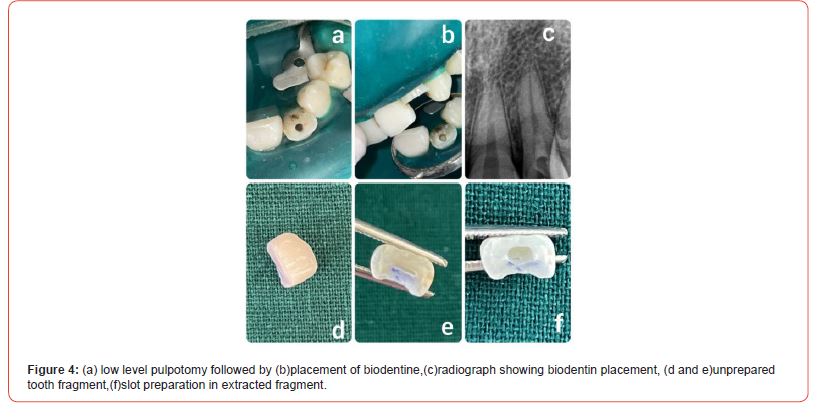
Low level pulpotomy was followed by placement of Biodentine as a conservative approach to maintain tooth vitality, and the same was explained to the patient. The attachment of the fragment to the remaining tooth structure was done using fibre post wherein, post space was prepared in coronal portion of root as well as in the fragment to ensure stabilization. After etching which, the fragment was reattached using dual cure resin cement (Figures 4, 5). A small bevel was given on the labial surface and composite masking was done to achieve good esthetics after 2 monthes follow up (Figures 4, 5).
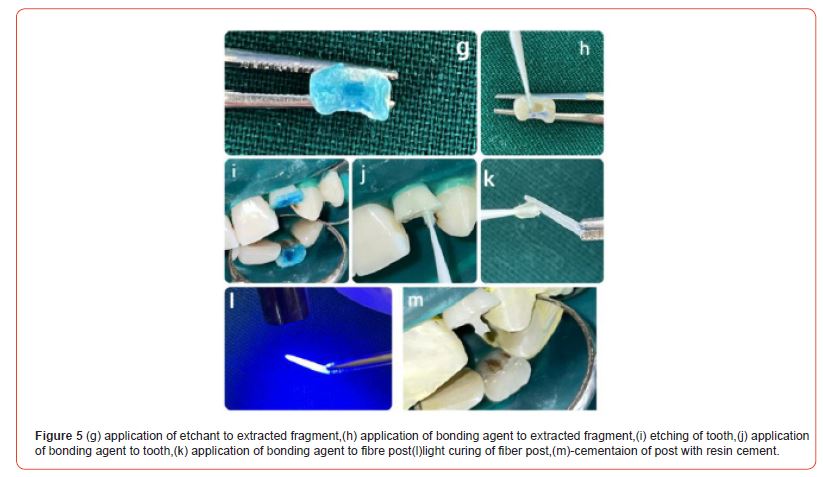
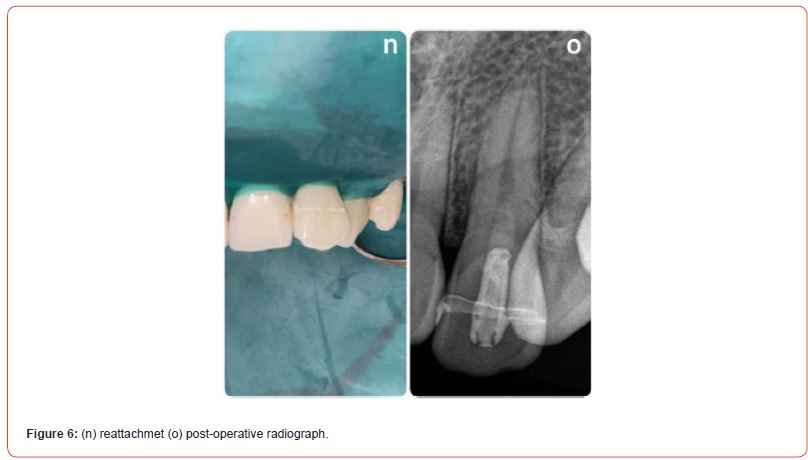
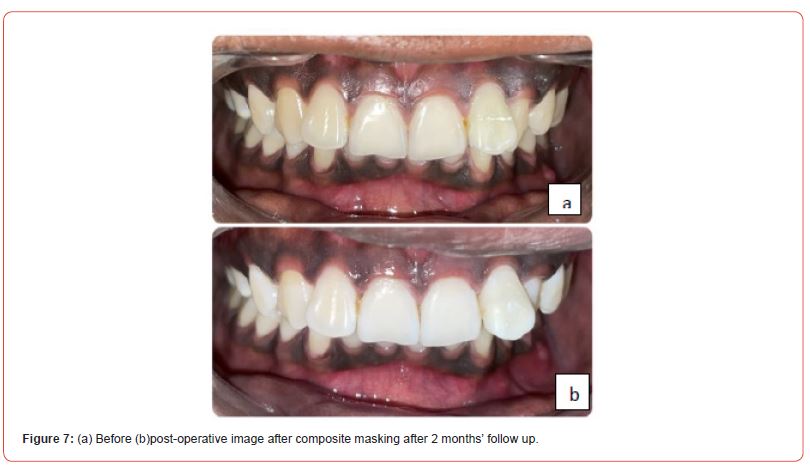
Discussion
The development of adhesive restorative materials has provided new perspectives for the treatment of fractured teeth. Thus, fragment reattachment becomes a fast, simple, and conservative technique that provides excellent rehabilitation of the esthetics and function.
Dehydration of the fragment may result in a change in dental colorand reduces the fracture resistance of the tooth. Proper rehydration of the fragment has the capability of restoring both color and strength. According to study done by Shirani et al, authors observed that the optimal rehydration time was equal to, but not less than, 24 hours [4].
Hence in the present case series the decision to reattach the fragment after a delay of 24 hours was considered. An attempt was made to render a very noninvasive procedure by providing esthetics as well as strength to the tooth [5, 6].
Conclusion
Fragment reattachment is a simple, fast, affordable, and esthetically predictable technique. It should always be the treatment of choice when the fragment is present and is in good condition.
Acknowledgement
None.
Conflict of Interest
No conflict of interest.
References
- Terry DA (2003) Adhesive reattachment of a tooth fragment: the biological restoration. Pract Proced Aesthet Dent 15(5): 403-409.
- Taguchi CM, Bernardon JK, Zimmermann G, Baratieri LN (2015) Tooth fragment reattachment: A case report. Oper Dent 40(3): 227-234.
- Reis A, Francci C, Loguercio AD, Carrilho MR, Filho LE (2001) Re-attachment of anterior fractured teeth: fracture strength using different techniques. Oper Dent 26(3): 287-294.
- Shirani F, Malekipour MR, Manesh VS, Aghaei F (2012) Hydration and dehydration periods of crown fragments prior to reattachment. Oper Dent 37(5): 501-508.
- Vilela EA, Baratieri LN, Caldeira de Andrada MA, Monteiro Jr S, Medeiros de Araújo J (2003) Tooth fragment reattachment: fundamentals of the technique and two case reports. Quintessence International 34(2).
- Macedo GV, Diaz PI, DE O FERNANDES CA, Ritter AV (2008) Reattachment of anterior teeth fragments: a conservative approach. Journal of Esthetic and Restorative Dentistry 20(1): 5-18.
-
Dr. Nigel Antonio De Menezes, Dr. Pranjal Bhosale, Dr. Hemalatha Hiremath, Dr. Madhu Pujar and Dr. Aishwarya Sinha. Fractured Tooth Reattachment of Vital and Non Vital Tooth: A Case Series. On J Dent & Oral Health. 7(1): 2023. OJDOH.MS.ID.000654.
-
Dental practitioners, Minimally invasive dentistry, Gingival tissues, Posterior teeth, Dental practice, Proximal caries, Dental clinics, Dentists, Periodontal status, Resin restorations.
-

This work is licensed under a Creative Commons Attribution-NonCommercial 4.0 International License.






